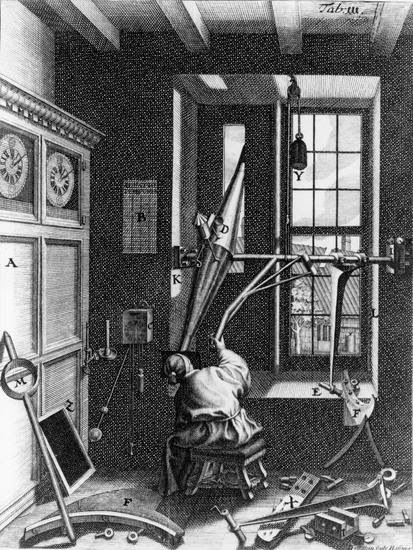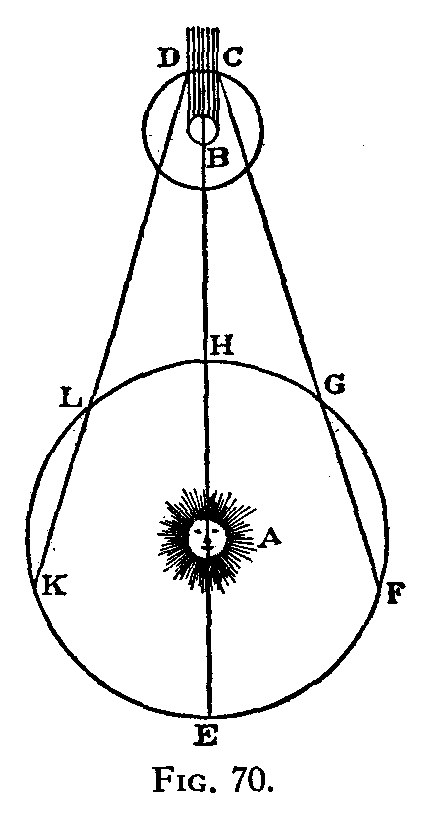
Ole Rømer (1644-1710)
On October 5, 1644 (or according to the old julian calendar September 25), Danish astronomer Ole Christensen Rømer was born. He became known by the first proof published in 1676 that the speed of light is finite and not infinite, respectively by the guidance, how the speed of light can be calculated by observation of the Jupiter moons.
Ole Rømer – Early Years
Ole Rømer was born in Århus, Denmark, to merchant and skipper Christen Pedersen (died 1663), and Anna Olufsdatter Storm (c. 1610 – 1690), daughter of a well-to-do alderman. From 1662 Rømer studied astronomy with Erasmus Bartholin in Copenhagen and worked with him until 1671, including the publication of Tycho Brahe‘s writings.[3] In 1671, the astronomer Jean Picard came to Copenhagen on behalf of the Paris Académie des Sciences to determine the geographical longitude of the old Tycho Brahe observatory on the island of Hven, Øresund.[8] With the determination of the difference of the length between Hven and Paris (longitude problem) the exact tables of Tycho Brahe could also be used in Paris. The orbit of the Jupiter moons had to be observed. The assistant Ole Rømer helped so skilfully with this work that he was invited to come to Paris with Picard at the end of the measurement series in April 1672. Rømer agreed and worked as a member of the Academy with Giovanni Domenico Cassini at the Paris Observatory.[4] In 1672 he developed a micrometer for telescopes and built mechanical models for planetary orbits (Jovilabium (1677), Saturnarium (1678), Lunarium (1680)). He developed a novel epicyclic gear for this purpose. These planetariums were designed to facilitate long astronomical observations.
Royal Danish Astronomer
In 1676 Rømer was appointed royal Danish astronomer and went from Paris to the University of Copenhagen in 1681. There he became professor of mathematics. In 1681 he married the daughter of Bartholin, who died in 1694 (he married her sister in 1698). In 1683 he introduced in the Kingdom of Denmark a nationwide uniform system of measures of length and weights. Around 1700Rømer developed an accurate measuring instrument for star positions, the meridian circle. With it he wanted to provide conclusive proof for the model of the solar system by Nicolaus Copernicus by measuring star parallaxes of Sirius. The proof succeeded only in 1838 by Friedrich Wilhelm Bessel.[7] On 1 March 1700 Denmark introduced the Gregorian calendar at Rømer’s suggestion.[6] In 1702 he built the first thermometer with two fixed points (Rømer scale), which Fahrenheit further developed after a visit to him (1708). About 1705 Rømer derived a measuring error formula for his meridian instrument in his Adversaria. Today this measuring error formula is attributed to Tobias Mayer, who found it 51 years later, i.e. 1756, without knowing Rømer’s derivation. Through his precise observation, Rømer succeeded in proving that the star Castor in the constellation of twins is a double star system. Finally he took part in the observation action of Mercury’s transit in front of the Sun on 5 May 1707 and evaluated it.

Ole Rømer at work
After Rømer had held various political offices since 1688, he became mayor of Copenhagen in 1705, head of the police and senator. In these functions he introduced far-reaching improvements, including the first street lighting (using oil lamps), renovation of water supply and sewerage. He held these posts until his death on September 19, 1710. He was buried in Copenhagen Cathedral.
Measuring the Speed of Light
The question of whether the speed at which light propagates is finite or infinite has been the subject of controversial debate for centuries. Supporters of Aristotle, among them René Descartes, pleaded for infinite speed of light. In 1668 Cassini had published his first tables in Bologna, which gave a timetable for the eclipses of the four Jupiter moons. The times given there helped with the longitude problem. Already from 1668 he had noticed deviations between timetable and observation. From 1672 Rømer continued his observations in Paris. Not only systematic deviations were confirmed, but the assumption that the eclipses – in comparison to the prediction – occurred earlier when the Earth approaches Jupiter (B) on its annual orbit around the Sun (A) on the circular arc from E via F and G to the opposition position H (see drawing by Rømer below), and later than predicted by the timetable, when the Earth departs from Jupiter from H via L and K to the conjunction position E, was confirmed.

A diagram of Jupiter (B) eclipsing its moon Io (DC) as viewed from different points in earth’s orbit around the sun. From Olaf (Ole) Roemer, “Demonstration tovchant le mouvement de la lumiere trouvé par M. Römer de l’ Academie Royale des Sciences,” December 7, 1676.
The reason for this is that the path of light between Jupiter and Earth changes, and thus – if the speed of light is a finite quantity – also the transit time of light. On 23 August 1676 Rømer dared to predict that the eclipse of the moon Io (DC) on 9 November 1676 would be visible “too late” by ten minutes. When this delay actually occurred, he presented his statement to the Royal Academy of Sciences in Paris on 21 November 1676 and published it on 7 December 1676 in the Journal des sçavans under the title Démonstration touchant le mouvement de la lumière trouvé par M. Roemer de l’Académie des sciences.
How Fast Is It?
In this article, however, it is not the speed of light that is given, but only the time it takes for light to pass through the diameter of the Earth’s orbit. According to Rømer’s calculation, the value was about 22 minutes; the correct value is about 17 minutes. For Rømer it was particularly important to show that the light does not propagate instantaneously but at finite speed. Rømer only gave an upper estimated value for the speed of light: for the diameter of the earth the light takes less than one second, according to today’s knowledge it is only 0.0425 s. A value for the speed of light was first calculated in 1678 by Christiaan Huygens with about 212,000 km/s in today’s units.[5]
How the Speed of Light Was First Measured, [9]
References and Further Reading:
- [1] Ole Rømer, the speed of light, the apparent period of Io, the Doppler effect,and the dynamics of Earth and Jupiter
- [2] Ole Rømer at Britannica Online
- [3] Tycho Brahe – The Man with the Golden Nose, SciHi Blog
- [4] Giovanni Cassini and Saturn Moon Rhea
- [5] Christiaan Huygens and the Discovery of Saturn Moon Titan
- [6] The Days That Never Happened – The Gregorian Calendar, SciHi Blog
- [7] Friedrich Bessel and the Distances of Stars, SciHi Blog
- [8] Jean Picard and his Love for Accuracy, SciHi Blog
- [8] Ole Rømer at Wikidata
- [9] How the Speed of Light Was First Measured, Educational Video Library @ youtube
- [10] Bobis, Laurence; Lequeux, James (2008). “Cassini, Rømer and the velocity of light”. J. Astron. Hist. Herit. 11 (2): 97–105.
- [11] MacKay, R. Jock; Oldford, R. Wayne (2000). “Scientific Method, Statistical Method and the Speed of Light”. Statistical Science. 15 (3): 254–278.
- [12] Timeline of 17th Century Danish Scientists via DBpedia and Wikidata





